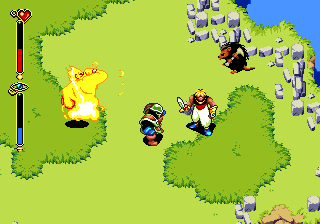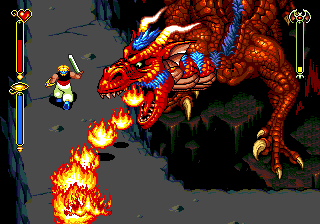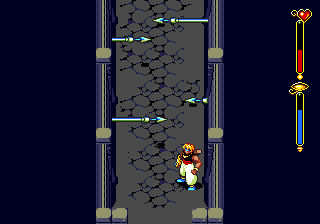Bucketlog July: Beyond Oasis
By Mento 0 Comments
Welcome to the Bucketlog! It's going to be 2019's year-long blog series, focusing on games I've been meaning to play since forever. I've put together a list derived from a mix of systems, genres, and vintages because it's starting to look like 2019 might be the first "lean" year for games in a spell (though time will tell whether that pans out to be true) and I figured this would be a fine opportunity to finally tick off a few items I've had on my various backlog lists/spreadsheets for longer than I'd care to admit.
July
- Game: Ancient's Beyond Oasis.
- System: Sega Mega Drive.
- Original Release: 12/08/1994.
- Time from Release to Completion: Twenty-four years, seven months, twenty-one days.
Completely incidentally, my E3 Trailer Review lists (which took approx. 30 days to write and were read by approx. 3.0 people) mentioned the phenomenon of "rival Zeldas": those games created on systems that obviously could not be the home of Nintendo's second best known franchise, such as the contemporaneous consoles produced by Sega, NEC, Microsoft, and Sony, and so had to make do with pale imitations. The Zelda blueprint is a very specific thing: you combine overworld exploration with dungeons filled with combat encounters and puzzles to solve, which for all the world feels like an RPG were it not for the lack of any true character progression, and then top it off with a pseudo open-world sensibility that nonetheless railroads you into completing dungeons in a specific order (though not always). The cartoonish fantasy aesthetic of Zelda is its own thing too, of course, and many Zelda clones will even try to imitate that as well.
Long ago I spent some time with the two Neutopia games - the TurboGrafx-16's take on The Legend of Zelda - for some TG16 features, the two of which will now fall under some scrutiny once again when the TG16 Mini is released. However, despite my many recent forays with the Sega Genesis/Mega Drive library, I've yet to see what its spins on that formula are like. That's why I plucked out Beyond Oasis (known as Story of Thor in Europe and Japan) as my bucketlog entry for July: I needed something brief and action-packed to offset all the RPGs I have scheduled; I intend to resume the Mega Archive feature sometime later next month and needed a lead-in; and I'm still fascinated with what different developers take away from the Zelda franchise as its high points worth emulating and low points best left by the wayside. In a fashion, games like Beyond Oasis are an adaptation of what someone's ideal Legend of Zelda successor might look like; in more pragmatic terms, however, it's usually whatever the developer can throw together to compete with the geniuses at Nintendo's various R&D divisions.

Now, I'm being awfully harsh on Beyond Oasis for both implying it's a straight Zelda clone and that it's a low grade knock-off to boot, because the game's pretty decent and its mechanics are sufficiently distinct enough to escape any direct comparisons. If I had to put a label on it, I'd say Beyond Oasis sits somewhere between A Link to the Past and a classic fantasy-themed Sega brawler like Altered Beast (I'm using "classic" purely to mean aged in the case of that one) or Golden Axe. Same flavor of tinny but endearing music, anguished 16-bit enemy death noise samples, an acrobatic variance of jump kicks and sword slashes, and plenty of scenarios where you have to clear the room of armored goons before you can proceed. Actually, if I had to pick out its closest SNES equivalent, I'd probably opt for Quintet's Terranigma: that martial artist combat repertoire combined with the Zelda slanted top-down perspective and puzzles with a bit of open-world exploration and item backtracking mixed in for color, just without Terranigma's meditative weirdness about the cosmic cycle of death and rebirth. I'm probably just in that mindset because the founder of Ancient and the game's composer, Yuzo Koshiro, also did the music for the ActRaiser games (also by Quintet). Similar degree of pomp and circumstance, ideal for a game where you play as a Prince shirking his duties by going off adventuring.
The Prince in question, Ali (Thor in the original version), finds a Gold Armlet on his latest expedition, which in turn draws out an ancient evil who sends his minions to capture it. The Armlet has the unique ability to command elemental spirits: a lot of the game's puzzles revolve around recruiting these spirits, summoning them in the field (by using the armlet on certain elemental nodes, like a pool of water for the water sprite Dytto for example, which is itself another component of the game's puzzles), and using their talents to progress past the current area. Spirits drain Ali's mana bar while they're out, though the bar slowly replenishes itself once the spirits are gone, and so you're often juggling between elemental spirits for their combat support if there's no immediate puzzle to be solved. Dytto, for instance, has a helpful healing spell that makes her useful right up to the end-game, while Efreet the fire spirit will float around sucker-punching fools as a useful bit of crowd control. Although there's only four spirits total, and the last is introduced close to the end of the game, all four provide ample reason to keep summoning them throughout the game's runtime between the puzzles they're required for and the help they offer. When not depending on spirits, Ali has a number of weapons and healing items on-hand to help him through combat, as well as a mix of combat skills that - like a brawler - can be modified depending on if Ali is jumping or running, as well as the distance to his foe. With the exception of Ali's starting dagger, the weapons all have finite endurance (I guess there's more of a Breath of the Wild than A Link to the Past comparison to be made) but the most valuable - and hardest to reach - finds in the game are weapons with infinite endurance, including bombs, swords, and crossbows. If you intend to eschew these infinite weapons and their ridiculous prerequisites - recall Final Fantasy X's Celestial Weapons and the hoops you have to jump through for those, and you're in the right ballpark - the alternative weapons serve as limited means to quickly clear out certain enemy encounters that might otherwise prove troublesome: this could involve holding back the fire arrows until you're surrounded by undead, for example, as they'll die in one hit from flames.

There's also the game's presentation, which is uniformly fantastic. Even if I don't care for the Mega Drive sound chip, Koshiro's soundtrack is both rousing and atmospheric and lends itself well to the variation of dungeons that the game presents. The enemy sprites are big and colorful, as is Ali himself, and it follows the brawler protocol of making each blow feel visceral as it connects with the appropriate "clang" and "whump" and "ugh!" foley work. Though there's only a smattering of enemy types, they all present some amount of challenge and require approaching differently; the variance of weapons helps here, as some are a lot more effective against certain foes than the standard dagger (while others are a lot less). The ground textures are a little less pleasant to look at, and can create some unwanted ambiguity regarding which edges you can jump off and which are hard barriers. The game's quality of life provisions are also all over the place: you can save anywhere on the overworld and Dytto's supportive healing magic (as well as copious restorative food items) all but ensures long-term survival, but dungeons have this annoying habit of resetting all the locked doors and keys if you should accidentally leave. There are some clever tricks to exploit as well, like how setting the basic rat enemies on fire is more likely to cause them to drop roast meat items - they provide a lot of healing potential - and if you can convince the piranha like fish to leap out of you and beach themselves, they'll eventually suffocate and turn into healing items themselves.
Beyond Oasis is definitely more than just a Zelda clone, even if its progression follows a familiar pattern: find a new dungeon, solve its key and switch puzzles, fight a boss at the end, collect a new spirit or some other valuable critical object, and get spat back out onto the overworld to figure out where to go next (the game mercifully highlights the next location for you). Like on any given Zelda overworld, it's often prudent to jot down locations where you need an presently-unavailable ability to proceed - either you'll need to come back that way later for the next dungeon, or you'll find some useful upgrade item there like colored gemstones that increase the power of their related spirit or the aforementioned infinite-charge weapons. Given those characteristics, it's easy to see how Sega were keen to present Beyond Oasis as their superior answer to The Legend of Zelda, even if that put it in the thankless position of trying to one-up both A Link to the Past and its eventual successor Ocarina of Time, released as it was in the median point between the two. I think those looking a little closer could see that Beyond Oasis was aiming for something very different, however. I'd readily put it on the same vaunted podium as something like Alundra: a top-down action-adventure game that superficially resembles Zelda, and might well have been promoted as a Zelda successor back when it was new, but has a direction and style all of its own.

Though I won't be covering any more Mega Drive games on the Bucketlog - one game per system, if you recall the BS rule I made up - I'm nowhere near done talking about the system in the near future. As well as resuming the Mega Archive, I also want to carve out some time to dig into Crusader of Centy - a.k.a. Soleil, a.k.a. the even more flagrant Mega Drive Zelda clone - and perhaps Treasure's sorta similarly structured isometric action-RPG Light Crusader (or, if we're sticking with isometric games, I could give Sega/Climax's Landstalker another try). Be sure to stay tuned for any or all of that in the weeks and months to come, fellow Sega dorks.
